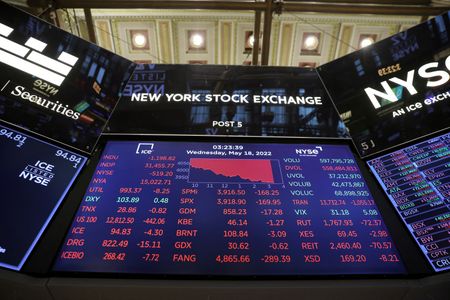
By Lewis Krauskopf, Devik Jain and Anisha Sircar
(Reuters) – Wall Street’s main indexes ended with slim losses on Wednesday after choppy trading as energy shares weighed and investors digested Federal Reserve Chair Jerome Powell’s comments on the central bank’s aim to bring down inflation.
After opening lower, major U.S. indexes had erased losses following Powell’s testimony before a Senate committee, but then they faded into the close.
Powell said the Fed is “strongly committed” to bringing down inflation that is running at a 40-year high while policymakers are not trying to cause a recession in the process.
Investors are trying to assess how far stocks could fall as they weigh risks to the economy with the Fed hiking rates to tamp down surging inflation. The S&P 500 earlier this month fell over 20% from its January all-time high, confirming the common definition of a bear market, with the benchmark index last week logging its biggest weekly percentage drop since March 2020.
“Markets continue to be volatile,” said King Lip, chief strategist at Baker Avenue Asset Management in San Francisco. “Certainly we are not out of the woods yet… The concerns are still there.”
The Dow Jones Industrial Average fell 47.12 points, or 0.15%, to 30,483.13, the S&P 500 lost 4.9 points, or 0.13%, to 3,759.89 and the Nasdaq Composite dropped 16.22 points, or 0.15%, to 11,053.08.
The energy sector, which has been a strong performer this year, fell 4.2% as oil prices slid. Declines in Exxon Mobil, Chevron and Conocophillips were the biggest individual drags on the S&P 500.
A 0.4% decline in the heavyweight technology sector also weighed.
Defensive areas real estate, healthcare and utilities were the top-gaining S&P 500 sectors. Real estate rose 1.6%, healthcare gained 1.4% and utilities added 1%.
In company news, Moderna Inc shares rose 4.7% after the company said an updated version of its COVID-19 vaccine generated a strong immune response against fast-spreading Omicron subvariants.
Dow Inc shares slid 4.7% after Credit Suisse downgraded the chemicals maker’s stock to “underperform.”
Declining issues outnumbered advancing ones on the NYSE by a 1.17-to-1 ratio; on Nasdaq, a 1.08-to-1 ratio favored decliners.
The S&P 500 posted one new 52-week highs and 39 new lows; the Nasdaq Composite recorded nine new highs and 207 new lows.
About 12.2 billion shares changed hands in U.S. exchanges, compared with the 12.5 billion daily average over the last 20 sessions.
(Reporting by Lewis Krauskopf in New York, Devik Jain, Anisha Sircar and Sruthi Shankar in Bengaluru and Boleslaw Lasocki in Gdansk; Additional reporting by Karen Brettell in New York; Editing by Cynthia Osterman)

